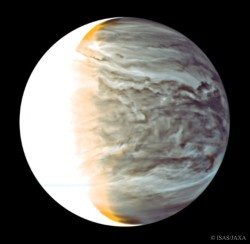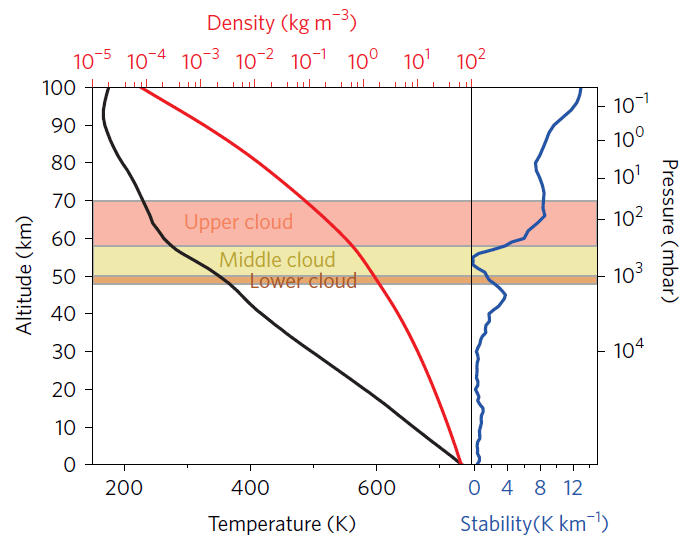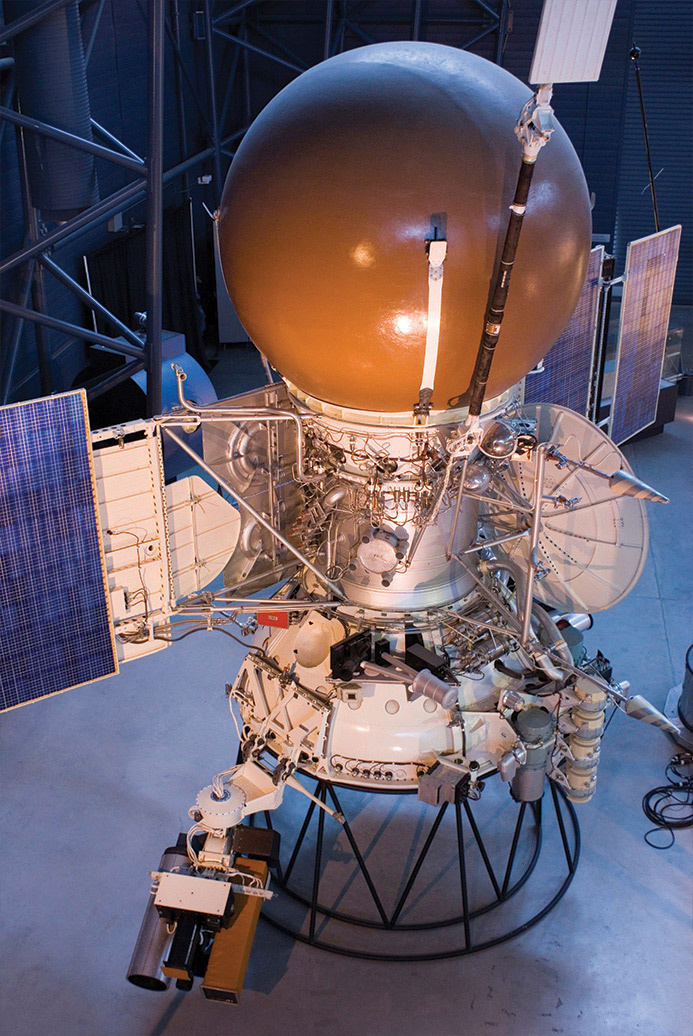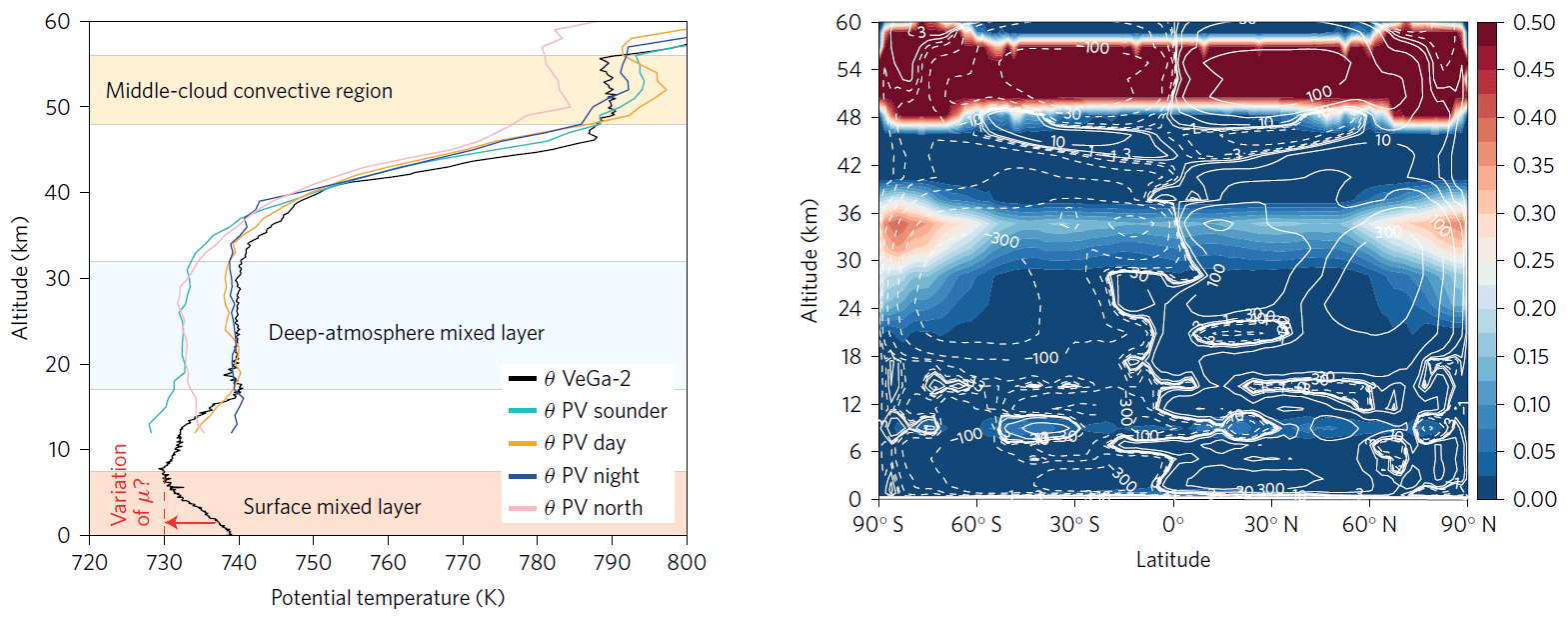According to the testimony of the Soviet probe "Vega-2", scientists have derived that the lower atmosphere of Venus is a supercritical fluid.
 On June 15, 1985, the descent module of the Soviet Vega-2 spacecraft sat on the surface of Venus in the area of the Rusalka Valley (7.14 ° S lat. 117.67 ° E) and transmitted a signal for 56 minutes. Passing through the atmosphere, he collected her only full temperature profile to date.
On June 15, 1985, the descent module of the Soviet Vega-2 spacecraft sat on the surface of Venus in the area of the Rusalka Valley (7.14 ° S lat. 117.67 ° E) and transmitted a signal for 56 minutes. Passing through the atmosphere, he collected her only full temperature profile to date.
As expected, the atmosphere was very dense and heavy. Atmospheric pressure on the surface is 92 bar, that is, about 92 times higher than on Earth, and the temperature is 464 ° C. The density of the atmosphere at the surface is about 6.5% of the density of liquid water. At 96.5% it consists of CO 2 , at 3.5% - from N 2 (by volume).
The density of the atmosphere of Venus is so high that its movement could even make Venus stop the rotation, and then begin to slowly rotate in the opposite direction (there is such a theory). Now Venus slowly rotates in the direction opposite to the earth, and makes one revolution around the axis for 243.02 Earth days.
Unexpected for scientists was that according to the testimony of "Vega-2" the atmosphere of Venus was rather unstable at an altitude of less than 7 km - this layer is much hotter than the layer above. In fact, these readings from the Soviet probe are still unexplained. Now scientists have proposed a new explanation for this unusual sensor readings. They believe that in fact the lower layers of the atmosphere are a supercritical fluid .
A pair of scientists, Sebastien Lebonnois from the laboratory of meteorological dynamics of the University of Pierre and Marie Curie (France) and Gerald Schubert, from the Department of Earth, Planetary and Space Sciences, University of Los Angeles Angeles (United States).
The vertical structure of the atmosphere of Venus according to the simulation results is shown in the diagram. Vertical profiles show changes in temperature, density and stability of the atmosphere, depending on the height and increase in atmospheric pressure. The location of the clouds is also shown. The information here is collected, including the results of decades of observations by other orbiters (Soviet Venera-15 and Venera-16, American Pioneer-Venera-1 and Magellan, European Venus-Express, Japanese Akatsuki "), Other probes, balloons and terrestrial telescopes.

All the data collected show that Venus, like Earth, has a troposphere that extends from the surface to the upper cloud layer at an altitude of about 60-65 km, and in the troposphere the temperature decreases with altitude. The bottom layer of clouds with sulfuric acid ends at an altitude of about 48 km. There, the temperature and pressure roughly correspond to the temperature and pressure on the surface of the Earth.
Immediately under the clouds, the atmosphere is relatively stable to about a height of 7 km, and here is the bottom layer is a puzzle. It is concentrated 37% of the mass of the entire atmosphere of Venus, it is there that the maximum pressure and temperature. It is extremely difficult to penetrate there and measure the atmospheric indicators. Reliably measure the temperature at low altitude, only the Soviet descent vehicle “Vega-2” in 1985 was able to.

Model of the spacecraft "Vega-2" in the branch of the National Air and Space Museum of the United States. The descent module is hidden inside the spherical shell
The measurements were carried out with two platinum wires, one bare, and the second in ceramic insulation, with an accuracy of ± 0.5 K in the range from 200 to 800 K. As already mentioned, the temperature rise is too sharp at an altitude below 7 km, until now to explain.
The authors of the scientific work draw attention to the fact that we do not have exact information about the chemical composition of the lower layer. They suggest that there is a different proportion of CO 2 and N 2 . In particular, the concentration of N 2 at the surface drops to zero. More precisely, as a result of ultra-high pressure at the surface, the separation of CO 2 and N 2 occurs. That is, the lighter N 2 rises to the upper atmosphere. Consequently, the true concentration of N 2 in the atmosphere can be 15% less than previously thought.

Vertical profile of potential temperature according to Vega-2 indications
Scientists make such conclusions based on the results of their experiments with supercritical fluids. The fact is that at high pressure and density, the difference between the liquid and gas phases of a substance disappears. Accordingly, the gas mixture may be partially divided into fractions, as it happens in a liquid. For example, for CO 2 the critical temperature is 303.9 K, the critical pressure is 72.8 atm, and the critical density is 0.468 g / cm 3 . As we see, the conditions at the surface of Venus may well create conditions for the transition of the atmosphere to the supercritical state.
The authors consider it necessary to conduct further studies of the atmosphere of Venus. If the probe cannot be sent there, then you can try to recreate the climatic conditions in the NASA laboratory.
The scientific work was published in the journal Nature Geoscience on June 26, 2017 (doi: 10.1038 / ngeo2971, pdf ).
All Articles